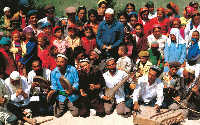| |
A Brief Introduction to Xinjiang Arts and Culture
( 2005-09-13 )
 Since the 1980s in particular, Xinjiang's cultural development has made enormous progress, benefiting from China's reform and opening-up process. In modern-day Xinjiang, a fairly comprehensive system of art forms has been established, including music, dance, theatrical arts,Quyi(folk/traditional narrative arts),acrobatics, fine arts, and so on. Cultural resources in Xinjiang are being fully tapped, which helps to fulfill the increasing cultural need of the Xinjiang people and provides unique impetus to the region's economic and social development. Since the 1980s in particular, Xinjiang's cultural development has made enormous progress, benefiting from China's reform and opening-up process. In modern-day Xinjiang, a fairly comprehensive system of art forms has been established, including music, dance, theatrical arts,Quyi(folk/traditional narrative arts),acrobatics, fine arts, and so on. Cultural resources in Xinjiang are being fully tapped, which helps to fulfill the increasing cultural need of the Xinjiang people and provides unique impetus to the region's economic and social development.
In today's Xinjiang, the culture and arts of all ethnic groups are thriving. There are now 89 professional performing arts groups (among which six are of autonomous region/provincial level, 24 of municipal level, and 59 of county level), two art research institutes, eight fine arts academies, and four art schools (including schools of both higher and middle-level education).
In recent years, China has conferred over 100 of its prestigious national arts awards to Xinjiang's performing arts productions. The prizes include "Wu Ge Yi Project Awards," "Wenhua Award," "China Arts Festival Award," and awards for all-China ethnic culture and arts joint performances. Many ethnic minority artists and musicians have earned high honors from various arts events at home and abroad.
Twelve Muqam, a rare example of Uygur musical heritage, was on the verge of extinction when it was rediscovered, written down as musical scores, and adapted to audio-visual products as well as stage shows.
Likewise, a large amount of money and energy have been invested since the 1980s to compile seven major art anthologies on Xinjiang's literature, music, dance, and theatrical arts, including the Xinjiang Volumes of such classics as China Folk and Traditional Dance Anthology and China Folk Songs Anthology.
Public cultural activities have also flourished, becoming grander and more sophisticated with five decades of development. The unique ethnic and local flavor of Xinjiang's public cultural activities has been heightened and is given full sway at such occasions as the "Grape Festival," the "Heavenly Horse Festival," the "Peach Festival," the Uygur Meshrep, the MongolNadam, the Kazak "Aken Music Party," the Kirgiz "Manas Sing-together," the Hui "Hua'er (Flowers) Singing Contest," and the Xibe "Westward Movement Festival." These colorful events, varying from every month and every town, have their deep roots among the people in rural areas. Meanwhile, in urban public places and cultural venues, performances and exhibitions are also being constantly held.
|
|

